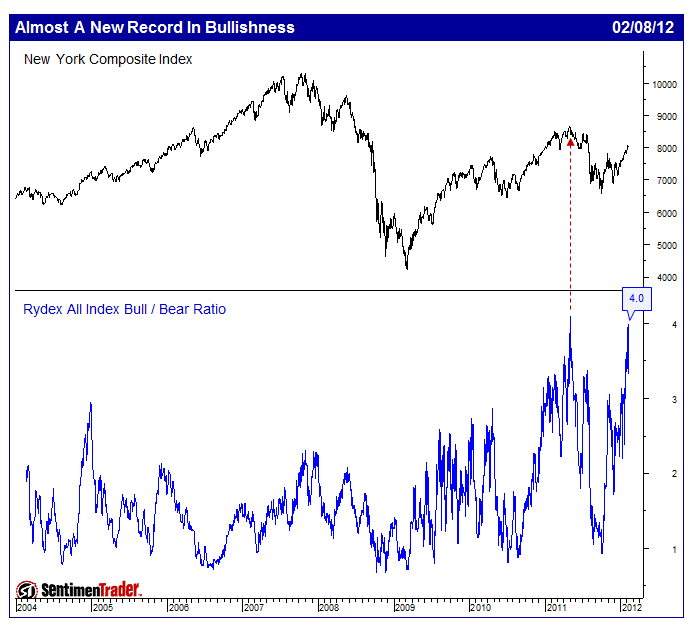We have now written about the
importance of observing historical volatility when making rebalancing decisions
(see here, here and here) and the importance of keeping portfolio volatility
low (see here). This post will discuss
the benefits inherent in volatility itself through the concept of “harvesting”
the volatility of individual positions within a portfolio.
We can simplify
the idea of volatility harvesting through a thought-experiment developed in the
1940s by Claude Shannon, renowned genius and investor, averaging 28% annually
in his lifetime! (Source: W. Poundstone, (2005) Fortune’s Formula). His experiment, known as Shannon’s Demon, showed
how it was possible to profit even from markets that were characteristic of a
random walk, as long as they were volatile.
The experiment
is simple: Imagine a stock that is highly jittery and either doubled or halved
in value every day. You then invest half of your portfolio in the stock, while the
rest remains in cash. At noon each day you rebalance the portfolio back to a
50-50 even split. So, if you started with $1,000 and the stock got cut in half,
the following day your portfolio would be $750 ($250 in the stock $500 in cash).
After rebalancing, the portfolio would have $375 in stock and $375 in cash. As
the chart below shows that after rebalancing only 72 times our $1,000 initial
investment is now worth just under $100,000! That is not a bad chunk of change
given that we didn’t have to do any stock forecasting to make this profit! In
fact, had you bought and held this stock you would make zero profit.
 |
| Source: Butler|Philbrick|Gordillo and Associates*
|
How can this be?
Well, the key is to understand that as long as there’s volatility in at least
one of your holdings you will benefit from the most basic of concepts in
portfolio theory: Rebalancing.
In the fictitious
case above we are looking at a stock that is volatile but has no return. What
if we were to do the same experiment and this time use two stocks that have low
correlation to each other but both lose money in the long-run? This is exactly
what was examined in a recent study done by Dempster, Evstigneev and
Schenk-Hoppe in “The Joy of Volatility”. Their experiment assumed that Stock A
would either gain +40% or lose -30% at each period and Stock B would either
lose -20% or gain +15% at each period (randomly). The results were impressive:
 |
Source:
Dempster, Evstigneev and Schenk-Hoppe
|
The author puts
it best by saying that “poverty is the inevitable fate of the passive investor.”
However, the active investor achieves certain success through rebalancing.
When applying
this to the real world the problem we face is in finding stocks that are
actually uncorrelated to one another to that degree. In today’s macro news
driven environment we find that most risky assets have become too highly
correlated.
So let’s apply
this concept to the real world, but instead of stocks let’s use two asset
classes we know to generally have low-to-negative correlation to one another:
stocks and bonds. Let’s work with the Japanese stock market (Nikkei 225), which
has lost -48% since 1995, and combine them with Japanese government bonds. We will rebalance this portfolio quarterly
using the dynamic volatility weighting method[i] (click here for
a detailed article on this simple concept).
 |
| Source: Butler|Philbrick|Gordillo and Associates*, data from Bloomberg |
This chart shows
how the use of an uncorrelated asset class along with simple rebalancing can
make a big impact on anyone’s investment success. The portfolio went from
losing -48% and having a peak-to-trough maximum loss of -79% in the Nikkei, to
making a profit of +138% and keeping the worst peak-to-though loss at a
manageable -13.97%. Though the result of
this two asset class portfolio is impressive, we
would in no way espouse this model as an optimal framework not least of which
because the stock / bond diversification ignores the myriad of opportunities
available from other markets and asset classes (Click here for more detail on
how we deal with this).
The
most important point behind these examples is that one doesn’t necessarily have
to be right about which stocks, sectors or other asset classes will do well in
the future, as long as they all experience bouts of uncertainty (i.e. volatility),
they are significantly uncorrelated to each other and you employ an active
portfolio approach designed to harvest that uncertainty. The math will take
care of the rest.
If you are an
avid risk junky and have always thought bonds were for losers, this exercise may
be a good way of helping you talk yourself into introducing some cash and bonds
into your otherwise risky portfolio. But make sure to always follow the number
one rule … don’t forget to rebalance!
[i] This is important in order to keep
the experiment in line with the Dempster study which requires us to keep the
bet sizes the same in each rebalancing period. In the example of the two stock
portfolio the odds are known in advance and the bet size is always constant. In
the real world, bet sizes change with volatility. It is only by controlling the
bet sizes through dynamic volatility sizing that we can come as close as
possible to the results in the two stock study. Having said this, even if one decides
to employ traditional equal dollar rebalancing quarterly we go from losing
money in the Nikkei to making a profit of +41% and keeping the drawdown to only
-33% (Click here for these results).












